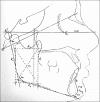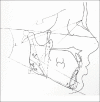Evaluation of mandibular morphology in different facial types
- PMID: 22090764
- PMCID: PMC3214527
- DOI: 10.4103/0976-237X.86458
Evaluation of mandibular morphology in different facial types
Abstract
The purpose of this study was to evaluate mandibular morphology in different facial types using various parameters. This study was conducted on lateral cephalograms of a total of 110 subjects, which included 55 males and 55 females between the age of 18-25 years having a mean of 22.3 years for males and 21.5 years for females. The sample was divided into normodivergent, hypodivergent, and hyperdivergent subgroups based on Jarabak's ratio. Symphysis height, depth, ratio (height/depth) and angle, antegonial notch depth, ramal height and width, mandibular depth, upper, lower, and total gonial angle, and mandibular arc angle were analyzed statistically and graphically. It was found that the mandible with the vertical growth pattern was associated with a symphysis with large height, small depth, large ratio, small angle, decreased ramus height and width, smaller mandibular depth, increased gonial angle, and decreased mandibular arc angle in contrast to mandible with a horizontal growth pattern. Sexual dichotomy was found with mean symphysis height and depth in the female sample being smaller than in the male sample, but symphysis ratio was larger in the female sample; males having greater ramus height and width, mandibular depth than females. The mandible seemed to have retained its infantile characteristics with all its processes underdeveloped in hyperdivergent group.
Keywords: Hyperdivergent; hypodivergent; mandibular morphology.
Conflict of interest statement
Figures
References
-
- Schudy FF. Vertical growth versus anteroposterior growth as related to function and treatment. Angle Orthod. 1964;34:75–93.
-
- Bjork A. Prediction of mandibular growth rotation. Am J Orthod. 1969;55:585–99. - PubMed
-
- Buschang PH, Tanguay R, Turkewicz J, Demirjian A, La Palme L. A polynomial approach to craniofacial growth: Description and comparison of adolescent males with normal Occlusion and those with untreated class II malocclusion. Am J Orthod Dentofacial Orthop. 1986;90:437–42. - PubMed
-
- Fields HW, Proffit WR, Nixon WL, Phillips C, Stanek E. Facial pattern differences in long-faced children and adults. Am J Orthod. 1984;85:217–23. - PubMed
-
- Zaher AR, Bishara SE, Jakobsen JR. Posttreatment changes in different facial types. Angle Orthod. 1994;64:425–36. - PubMed




